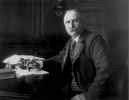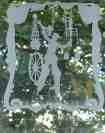|
Appendix Andrew Carnegie Married on the 1st of June 1887 to Louise Whitfield daughter of John W. Whitfield in New York, they had one child. Daughter called Margaret. Died on the 11th August 1919 at Lennox, Massachusetts, and United States of America. Buried in Sleepy Hollow Cemetery, Tarrytown, New York, United States of America. Source of information – The Dictionary of National Biography 1912 – 1919 Oxford University Press and Dornoch Library. Hew Morrison, Chief Librarian,
Edinburgh Married twice, the first marriage took place on the 23rd of December 1874, Montrose, to Agnes Jack daughter of Alexander Jack & Mary-Ann Crammond. Second Marriage took place on the 19th August 1881, Newington, Edinburgh, to Agnes Veitch daughter of George Veitch & Agnes Robertson. He died on the18th January 1935 at
12 Blackford Road, Edinburgh. So far I have not been able to find out
exactly how many children, Hew Morrison had. As he was married twice, this
was taken from 1881 census when he was a widower, his first wife Agnes
Jack had died before the census of 1881 by then there was only one child
mentioned a daughter called Emily. In 1901 census list of children was
mentioned there was one girl & four boys they were Agnes, Hew, Reay, James
& John this to his second wife Agnes Veitch. I have counted 2 daughters &
4 boys but there could be more. Sir John Usher They had seven children, five boys & two girls. Children as follows: John Andrew, Robert, Thomas Balmer, Frederick, Francis James, Agnes Stewart & Mary Ann. Died on the 24th March 1904 Cairo, Egypt. Buried at Grange Cemetery, Edinburgh. Source of information - The Dictionary of National Biography 1901 – 1911 Oxford University Press, www.familysearch.org & www.the-house-of-usher.co.uk Emeritus Professor David Mather
Masson. Married on the 27th August 1853 to Emily Rosaline Orme daughter of Charles Orme & Eliza Andrews, they had four children, three girls & one boy. Rosaline, Flora, Helen & Orme. In 1865 appointed to the post of professor of Rhetoric and English literature at the University of Edinburgh. Died 6th October 1907 in Locharton Gardens, Edinburgh buried at Grange Cemetery, Edinburgh. Source of information – The Dictionary of National Biography 1901 – 1911 Oxford University Press & www.familysearch.org John Mowat, F.S.A., (Scot.) Married Georgina Dunnet, daughter of George Dunnet and Charlotte Laird in Glasgow on the 12th July 1899. They had seven children, four girls & three boys. Charlotte, Margaret, Jessie, Chrystina, James George and John. He died on the 30th January 1955 in Manchester; his home address was 50 Southampton Drive, Glasgow. Buried in Glasgow. Effigy of St. Fergus
(Patron Saint of Wick) The figure dates from the end of 15th or the early part of the 16th century. It shows a man with long, tonsured hair, dressed in a loose, cassock-like garment with narrow, loose sleeves. His hands are folded across his breast, and hold a cross with notched ends to the arms. Small round bosses, probably representing jewels, are seen on the arms of the cross and on a small, lozenge-shaped addition at the intersection. His feet rest upon a crouched or sleeping lion. The effigy, blackened by the centuries and much disfigured by graffiti in the past has been partly cleaned. Further restoration work will be carried out in the future. Glass engraving on the window in
the library Excerpt from the John O’Groat Journal 12th April 1957 At a meeting of Caithness Library Sub-Committee on Friday, Dr F. W. Robertson, county librarian, informed the member that Mr James Robertson, architect, Glasgow, a native of Keiss, had gifted to the museum a photostatic copy of an 18th century broadsheet, showing a famous equilibrist, Duncan Macdonald, who was a native of Caithness. Submitting the copy for inspection by the members, Dr Robertson said: “This is a very rare sheet. I doubt if any modern man could perform this feat of balancing. Mr Robertson has given so many gifts to the library and we are indebted to him.” The sub-committee unanimously agreed to record their appreciation of the gift. This reproduction of the photostat of the engraving from the original drawing gives the artist’s impression of Macdonald performing his famous act. Underneath the following report appeared in the broadsheet. Refugee in France The Act
Index |






